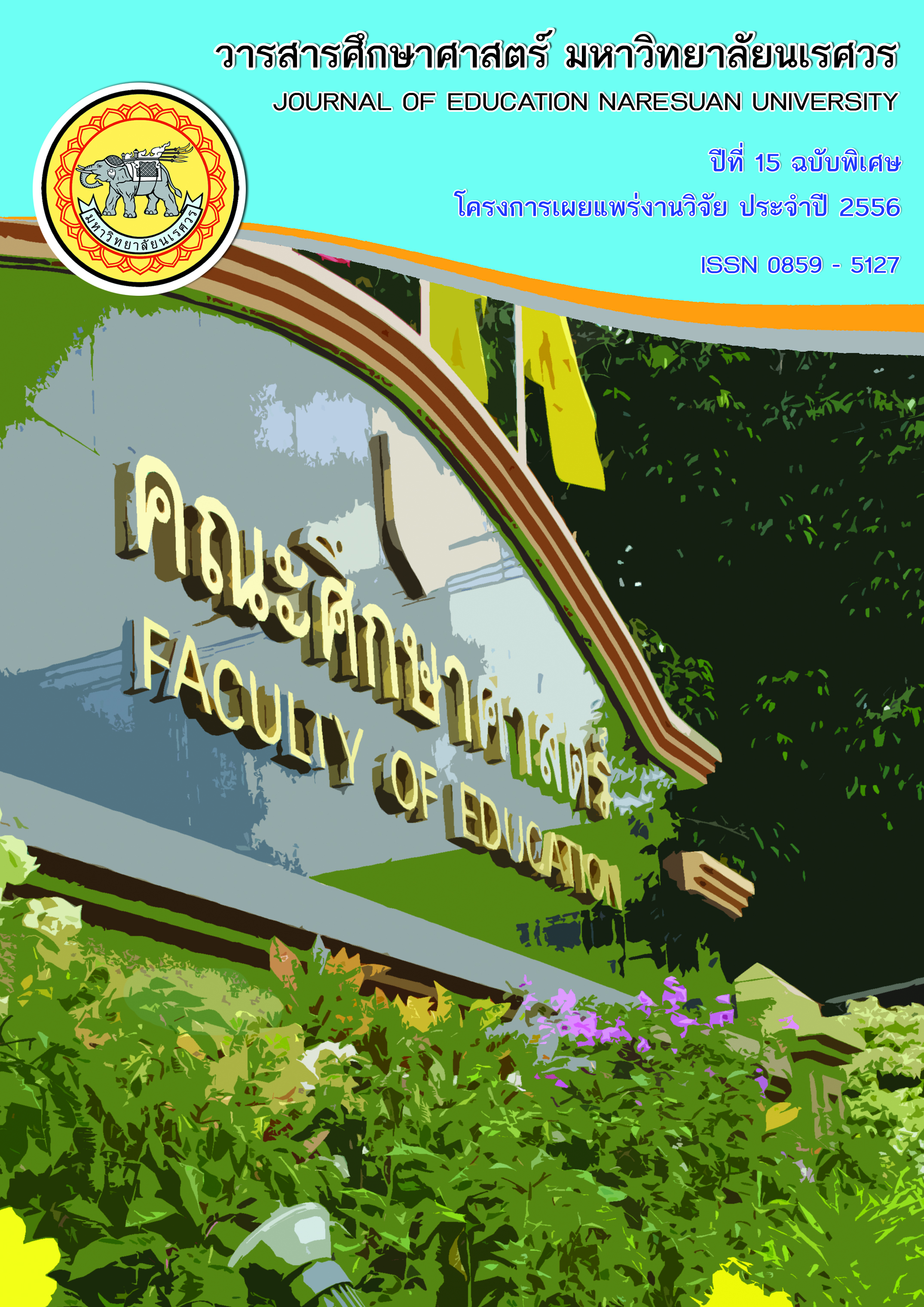การพัฒนารูปแบบการบริหารผลการปฏิบัติงานของครู สังกัดสำนักงานเขตพื้นที่การศึกษาประถมศึกษา
Main Article Content
Abstract
บทคัดย่อ
การวิจัยครั้งนี้เป็นการวิจัยแบบผสมผสานของการวิจัยเชิงคุณภาพและการวิจัยเชิงปริมาณโดยมีวัตถุประสงค์เพื่อพัฒนารูปแบบการบริหารผลการปฏิบัติงานของครู สังกัดสำนักงานเขตพื้นที่การศึกษาประถมศึกษา มีขั้นตอนการวิจัย 3 ขั้นตอน คือ ขั้นตอนที่ 1 การศึกษาสภาพ ความคาดหวัง และแนวทางการบริหารผลการปฏิบัติงานของครู โดยใช้วิธีพหุกรณีศึกษาและการสัมภาษณ์เชิงลึกผู้เชี่ยวชาญด้านการบริหารสถานศึกษา วิเคราะห์ข้อมูลโดยการวิเคราะห์เนื้อหาและสรุปอุปนัย ขั้นตอนที่ 2 การสร้างรูปแบบการบริหารผลการปฏิบัติงานของครู โดยนำผลการศึกษาจากขั้นตอนที่ 1 มายกร่างรูปแบบและตรวจสอบ ความเหมาะสมของรูปแบบโดยการประชุมสนทนากลุ่มผู้ทรงคุณวุฒิ จำนวน 10 คน วิเคราะห์ข้อมูลโดยการวิเคราะห์เนื้อหาและสรุปอุปนัย ขั้นตอนที่ 3 การประเมินรูปแบบการบริหารผลการปฏิบัติงานของครู โดยการจัดประชุมสัมมนาเพื่อรับฟังความคิดเห็นของผู้บริหารสถานศึกษาเพื่อประเมินรูปแบบและคู่มือการบริหารผลการปฏิบัติงานของครู วิเคราะห์ข้อมูลโดยใช้ค่าเฉลี่ย และค่าส่วนเบี่ยงเบนมาตรฐาน ปรากฏผลการวิจัยดังนี้
1. สภาพ ความคาดหวัง และแนวทางการบริหารผลการปฏิบัติงานของครู สรุปได้ว่า มีการกำหนดขอบข่ายงานและภาระงานในหน้าที่ความรับผิดชอบของครู และมีการดำเนินงานการบริหารผลการปฏิบัติงาน ซึ่งเป็นการดำเนินงานในระดับสถานศึกษา และระดับกลุ่มงาน ซึ่งผู้บริหารและคณะครูควรร่วมกันกำหนดขอบข่ายงานและภาระงานของครูให้มีความชัดเจน เหมาะสมสอดคล้องกับบริบทของสถานศึกษาและครูสามารถปฏิบัติได้จริง สำหรับการบริหารผลการปฏิบัติงานควรมุ่งเน้นการบริหารผลการปฏิบัติงานของครูในระดับบุคคลที่เชื่อมโยงกับผลการปฏิบัติงานในระดับกลุ่มงานและระดับสถานศึกษาให้มีความสอดคล้องกัน โดยมีแนวทาง การบริหารผลการปฏิบัติงานของครู ในด้านขอบข่ายงานในหน้าที่ความรับผิดชอบของครู พบว่า มี 4 งาน ได้แก่ 1) งานการจัดการเรียนการสอน มี 6 ภาระงาน 2) งานอบรมและพัฒนานักเรียน มี 4 ภาระงาน 3) งานดูแลช่วยเหลือนักเรียน มี 5 ภาระงาน และ 4) งานบริหารจัดการชั้นเรียน มี 3 ภาระงาน และด้านกระบวนการบริหารผลการปฏิบัติงานของครู พบว่า มี 5 ขั้นตอน ได้แก่ ขั้นตอนที่ 1 การวางแผนและกำหนดเป้าหมายผลการปฏิบัติงาน มี 3 แนวทาง ขั้นตอนที่ 2 การพัฒนาผลการปฏิบัติงาน มี 7 แนวทาง ขั้นตอนที่ 3 การติดตามและทบทวนผลการปฏิบัติงาน มี 3 แนวทาง ขั้นตอนที่ 4 การประเมินผลการปฏิบัติงาน มี 5 แนวทาง ขั้นตอนที่ 5 การให้รางวัลและโอกาส มี 2 แนวทาง โดยมีการติดต่อสื่อสารผลการปฏิบัติงานอยู่ในทุกขั้นตอน มี 2 แนวทาง
2. รูปแบบการบริหารผลการปฏิบัติงานของครู สังกัดสำนักงานเขตพื้นที่การศึกษาประถมศึกษาที่สร้างขึ้น มีความเหมาะสมที่จะนำไปใช้ในสถานศึกษา ประกอบด้วย 2 องค์ประกอบ ได้แก่
2.1 ขอบข่ายงานในหน้าที่ความรับผิดชอบของครู มี 4 งาน ดังนี้ งานการจัดการเรียนการสอน มี 6 ภาระงาน งานปลูกฝังและพัฒนานักเรียน มี 5 ภาระงาน งานดูแลช่วยเหลือนักเรียน มี 5 ภาระงาน งานบริหารจัดการชั้นเรียน มี 5 ภาระงาน
2.2 กระบวนการบริหารผลการปฏิบัติงานของครู มี 5 ขั้นตอน ดังนี้ ขั้นตอนที่ 1 การวางแผนและกำหนดเป้าหมายผลการปฏิบัติงาน มี 3 แนวทาง ขั้นตอนที่ 2 การพัฒนาผลการปฏิบัติงาน มี 7 แนวทาง ขั้นตอนที่ 3 การติดตามและทบทวนผลการปฏิบัติงาน มี 3 แนวทาง ขั้นตอนที่ 4 การประเมินผลการปฏิบัติงาน มี 5 แนวทาง ขั้นตอนที่ 5 การให้รางวัลและโอกาส มี 2 แนวทาง โดยมีการติดต่อสื่อสารแบบสองทางอยู่ในทุกขั้นตอน มี 2 แนวทาง
3. การประเมินรูปแบบการบริหารผลการปฏิบัติงานของครู พบว่า ขอบข่ายงานในหน้าที่ความรับผิดชอบของครู มีความเป็นไปได้และมีความเป็นประโยชน์อยู่ในระดับมากที่สุด และกระบวนการบริหารผลการปฏิบัติงานของครู มีความเป็นไปได้อยู่ในระดับมากและมีความเป็นประโยชน์อยู่ในระดับมากที่สุด สำหรับคู่มือการบริหาร ผลการปฏิบัติงานของครูในภาพรวมมีความเหมาะสมอยู่ในระดับมากที่สุด
คำสำคัญ: การบริหารผลการปฏิบัติงานของครู
Abstract
This mixed methodology study, comprised quantitative and qualitative research. The objective of this research was to develop a model for teacher performance management under the jurisdiction of the primary education service area office. The research procedure comprised of 3 steps. First, studying about state, expectations and guidelines for the teacher performance management by using the multi – case studies, in-depth interview of the professionals in administration. The data were analyzed through content analysis and analytic induction. Second, constructing a tentative model for teacher performance management by using the results from the first step; the appropriateness of the model was checked through focus group discussion among 10 educational experts; the data were analyzed through content analysis and analytic induction. Third, evaluating the constructed model for the teacher performance management along with its manual for its feasibility and usefulness by holding a seminar among the selected academic administrators; their points of view were collected, and the data analyzed, using means and standard deviations. The results of the research were as follows:
1. State, expectations and guidelines for teacher performance management were found to have been delineated in terms of the framework of teachers’ duties and responsibilities, and the operation of teacher performance at the school and teamwork level. The administrators and teachers were expected to cooperatively clarify them in accordance with the context of schools in such a way that the teachers can practice. The teacher performance management should focus on the individual level, which is connected to the results at the teamwork and school level. Guidelines for teacher performance management encompass 4 tasks in the framework of teachers’ duties and responsibilities: 1) Learning management with 6 workloads, 2) Students training and development with 4 workloads, 3) Students helping service with 5 workloads and 4) Classroom managements with 3 workloads.
The teacher performance management were found to be composed of 5 components: 1) Planning and objective setting for of teacher performance, with 3 guideline practices.
2) Development of performance with 3 guideline practices
3) Monitoring the performance with 3 guideline practices.
4) Evaluation the performance with 3 guideline practices.
5) Reward and opportunities with 2 guideline practices, all of which are under the umbrella of administrative communications.
2. The constructed model for teacher performance management, validated as appropriate for use in the schools, consists of 2 components:
2.1. Framework of teacher duties and responsibilities, consisting of 4 tasks with associated workloads: 1) Learning management with 6 workloads 2) Students training and development with 5 workloads, 3) Students helping service with 5 workloads, and 4) Classroom managements with 5 workloads.
2.2. Five –step process of teacher performance management: 1) Performance planning with 3 associated guideline practices, 2) Performance development with 7 guideline practices, 3) Performance monitoring and review with 3 guideline practices, 4) Performance appraisal with 5 guideline practices, and 5) Reward and opportunity with 2 guideline practices, all of which are under the umbrella of administrative communications with 2 guideline practices.
3. The evaluation of the constructed model found that the framework of teacher’s duties and responsibilities is at the highest level of feasibility and usefulness. The process of teacher performance management is a high level of feasibility and the highest level of usefulness. The teacher performance management manual was evaluated at the highest level of appropriateness.
Key words: Teacher performance management
Article Details
The owner of the article does not copy or violate any of its copyright. If any copyright infringement occurs or prosecution, in any case, the Editorial Board is not involved in all the rights to the owner of the article to be performed.


